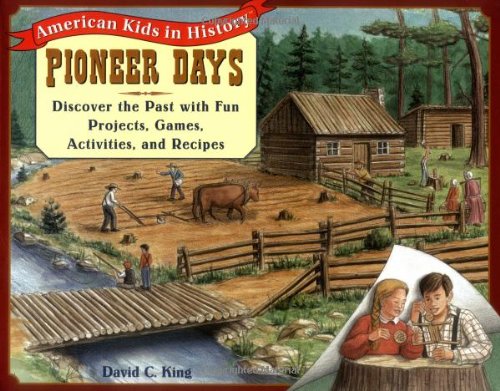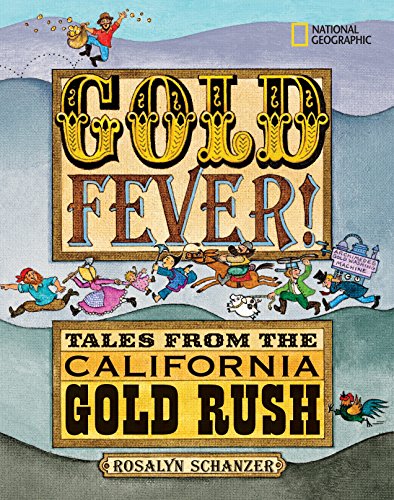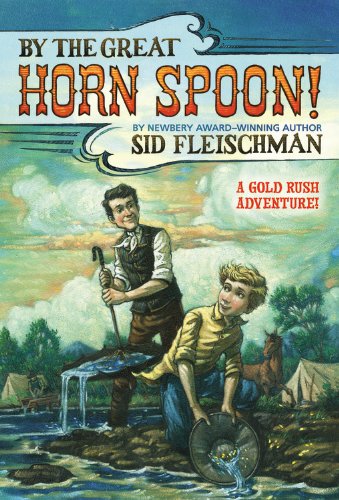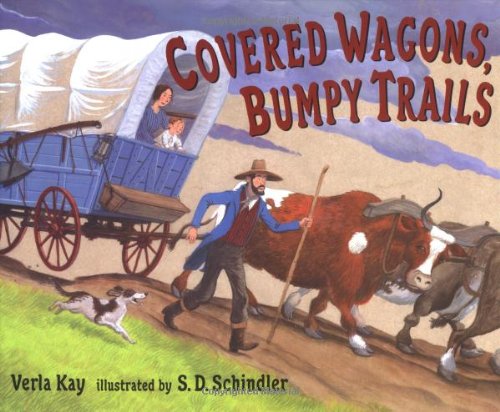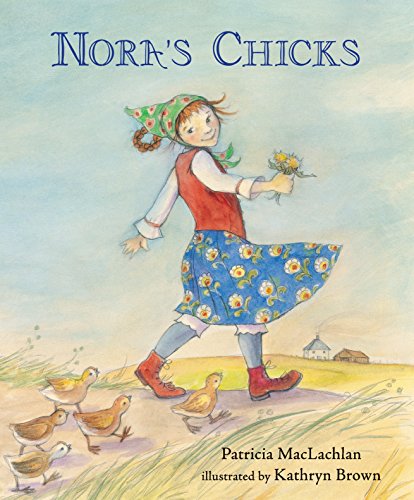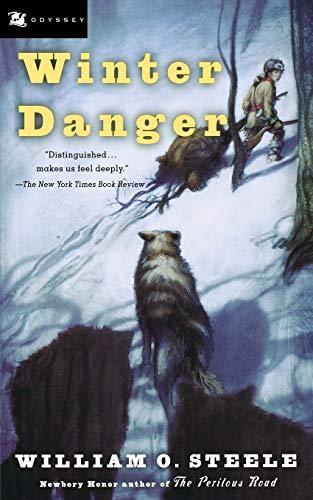On this page: General Resources | Louisiana Purchase | Lewis & Clark | Gold Rush | Pony Express | Railroad | Historical Fiction
general resources
📖 Which Way to the Wild West? Everything Your Schoolbooks Didn't Tell You About Westward Expansion by Steve Sheinkin. "History . . . with the good bits put back. Discover the drama, discoveries, dirty deeds and derring-do that won the American West." In this 9-chapter book, you will read about the Louisiana Purchase, the idea of Manifest Destiny, the Alamo, the Oregon Trail, Gold Fever, Cowboys, Native American conflicts, and much more. As always, Sheinkin's writing style is engaging, informative, and entertaining; highly recommended. – Elementary • Middle
📖 Tree in the Trail by Holling C. Holling. This story of the changing American West is centered around a single cottonwood tree on the Great Plains of Kansas. The tree bears witness to centuries of human activity, from Native American buffalo hunts to the westward movement of Europeans along the Santa Fe Trail. Published in 1942, the writing and illustrations are reflective of the era. – Elementary • Middle
🖐️ Pioneer Days: Discover the Past with Fun Projects, Games, Activities, and Recipes by David King. Move through the seasons alongside the Butlers, a fictional pioneer family in the year 843. This activity book is organized by season, and projects include making clay pots, drying herbs, making apple butter, and much more. – Elementary
🔗 Content Connection: Native Americans. Explore the impact of European westward movement on the First Americans.
▶️ War and Expansion from Crash Course. John Green teaches “about the Mexican-American War in the late 1840s and the expansion of the United States into the western end of North America.” – Middle • High
▶️ Westward Expansion from Crash Course. John Green breaks down the stereotypes of the Wild West for you, offering a more accurate picture of what was happening during the westward expansion of the 19th century. – Middle • High
louisiana purchase
▶️ The historical audacity of the Louisiana Purchase from TED-Ed. "When the French offered up the Louisiana Territory, Thomas Jefferson knew this real estate deal was too good to pass up. How did the President justify the purchase that doubled the size of the United States?" – All
lewis & clark expedition
📖 A Picture Book of Lewis and Clark and A Picture Book of Sacagawea by David Adler. This pair of books provides a fine overview of the expedition led by Lewis & Clark and greatly facilitated by their guide, Sacagawea. – Preschool • Elementary
📖 Seaman’s Journal: On the Trail with Lewis and Clark by Patricia Reeder Eubank. Here is the story of the famous expedition, as told by Meriweather Lewis’ Newfoundland, Seaman. Not surprisingly, Seaman’s entries reveal a particular fascination with the wildlife and the food. A great read, particularly for dog lovers. – Elementary
📖 How We Crossed the West by Rosalyn Schanzer. This exciting account of the Lewis & Clark expedition is enhanced by lively illustrations and excerpts from the explorers’ own journal entries. – Elementary • Middle
📖 Streams to the River, River to the Sea by Scott O'Dell. "A young Native American woman [Sacagawea], accompanied by her infant and her cruel husband, experiences joy and heartbreak when she joins the Lewis and Clark expedition seeking a way to the Pacific." Winner of the Scott O'Dell Award for Historical Fiction. – Middle
📖 Sacajawea by Joseph Bruchac. “Captured by her enemies, married to a foreigner, and a mother at age sixteen, Sacajawea lived a life of turmoil and change. Then, in 1804, the mysterious young Shoshone woman met Meriwether Lewis and William Clark. Acting as interpreter, peacemaker, and guide, Sacajawea bravely embarked on an epic journey that altered history forever. Hear her extraordinary story, in the voices of Sacajawea and William Clark in alternating chapters, with selections from Clark’s original diaries.” Bruchac is an American Book Award winning author whose knowledge and portrayal of Native American history are unparalleled. Highly recommended. – Middle • High
▶️ The true story of Sacajawea from TED-Ed. "Karen Mensing debunks some of the myths that surround the familiar image of the heroic woman with a baby strapped to her back and a vast knowledge of the American wilderness." – All
gold rush
📖 Chang's Paper Pony by Eleanor Coerr. Chang and his grandfather work in the kitchen of a California mining camp. Enduring loneliness and discrimination as a recent Chinese immigrant, Chang's dream is to one day to have his own pony. While it doesn't offer too much by way of factual detail, This I Can Read Book is a fine option for an independent read. – Preschool • Elementary
📖 Gold Fever: Tales from the California Gold Rush by Rosalyn Schanzer. This is the story of the California Gold Rush told mainly through quotes from the prospectors themselves. The text, along with Schanzer’s clever illustrations, nicely conveys the widespread excitement that followed the fateful discovery at Sutter’s Mill. – Elementary
📖 By the Great Horn Spoon by Sid Fleischman. “When Jack's aunt is forced to sell her beloved mansion but is still unable to raise enough money to pay her debts, the twelve-year-old goes to California in search of gold to help her. Joined by his trusty butler, Praiseworthy, Jack finds adventure and trouble at every turn. Will Jack strike gold in San Francisco or come home empty-handed?” Highly recommended. – Elementary • Middle
pony express
📖 Buffalo Bill and the Pony Express by Eleanor Coerr. This entertaining I Can Read title is a good choice if you’re looking to incorporate some independent reading practice into your history studies. – Preschool • Elementary
📖 Off Like the Wind! The First Ride of the Pony Express by Michael Spradlin. Although it lasted just a short while, the Pony Express continues to capture our imagination. Writing in the present tense, Spradlin provides an exciting day-by-day account of the triumphant first ride of the Pony Express. – Elementary
📖 They're Off! The Story of the Pony Express by Cheryl Harness. Here is your comprehensive book on the origins, operation and demise of the Pony Express. Harness' excellent book puts this short-lived enterprise into historical context, providing plenty of background information on 19th century westward expansion. – Elementary • Middle
railroad
📖 Locomotive by Brian Floca. It's easy to see why Locomotive recently won the Caldecott Medal—this is a great book to accompany your elementary study of the Transcontinental Railroad. The text and illustrations manage to be both very detailed and completely engrossing. – Preschool • Elementary
📖 Kate Shelley and the Midnight Express by Margaret K. Wetterer. Here is the true story of Kate Shelley, a young Iowan who braved a terrible storm to prevent a deadly train disaster. Written in an Easy Reader format, Kate Shelley and the Midnight Express is a good option for an emerging reader. – Elementary
📖 Coolies by Yin. In the mid-19th century, two Chinese brothers arrive in California to work on the transcontinental railroad. This fictionalized account examines the crucial role that Chinese workers played in the completion of the railroad, as well as the enormous hardships and injustices that these immigrants encountered. – Elementary
📖 Ten Mile Day and the Building of the Transcontinental Railroad by Mary Ann Fraser. This story of the transcontinental railroad tells how the hardworking men of the Central Pacific Railroad Company set a world record by laying over ten miles of track in a single day. – Elementary • Middle
historical fiction
📖 Pioneer Sampler: The Daily Life of a Pioneer Family in 1840 by Barbara Greenwood. "In an unusual blend of fiction and nonfiction, A Pioneer Sampler chronicles one year in the lives of the Robinson family. Illustrated historical notes enlarge on the social history and describe activities related to the stories, from churning butter to predicting the weather. Young readers are invited to try their hand at these tasks to experience a bit of pioneer life." Highly recommended. – All
📖 Covered Wagons, Bumpy Trails by Verla Kay. This book about the Oregon Trail is classic Verla Kay – very simple rhyming text and pictures that help to set the mood. It’s worth getting from the library, and is most appropriate for younger children. – Preschool
📖 Apples to Oregon by Deborah Hopkinson. The subtitle of this ebullient book about the Oregon Trail says it all: “being the (slightly) true narrative of how a brave pioneer father brought apples, peaches, pears, plums, grapes and cherries (and children) across the plains." – Preschool • Elementary
📖 Nora’s Chicks by Patricia MacLachland. After her family immigrates from Russia to the American prairie, Nora is terribly homesick and lonely until she makes a new friend. A gentle picture book from the author of Sarah, Plain and Tall. – Preschool • Elementary
📖 Dandelions by Eve Bunting. Papa enthusiastically moves Zoe, Rebecca, and Mama westward to the wide open plains of Nebraska. Through Zoe's eyes, we witness Mama's quiet distress at her lonely new life on the frontier. – Elementary
📖 Train to Somewhere by Eve Bunting. In Train to Somewhere, Marianne is sent west on one of the infamous 19th century orphan trains. This is another beautiful and evocative book from Eve Bunting. – Elementary
📖 Sarah, Plain and Tall by Patricia MacLachlan. "Sarah Elisabeth Wheaton comes from Maine to the prairie to answer Papa's advertisement for a wife and mother. Before Sarah arrives, Anna and her younger brother, Caleb, wait and wonder. Will Sarah be nice? Will she sing? Will she stay?" Winner of the Newbery Medal and the Scott O'Dell Award for Historical Fiction. – Elementary
📖 Dakota Dugout by Ann Turner. “Tell you about the prairie years? I’ll tell you, child, how it was.” With simple prose and just a bit of nostalgia, an older woman tells her granddaughter about her life as a young bride in a sod house on the Dakota prairie. The atmospheric illustrations beautifully capture the loneliness and isolation of pioneer life on the plains. – Elementary
📖 Little House in the Big Woods and others by Laura Ingalls Wilder. "Set during the pioneer days of the late 1800s and early 1900s, Laura Ingalls Wilder's books chronicle her life growing up on the Western frontier." Classic. – Elementary • Middle
📖 Caddie Woodlawn by Carol Ryrie Brink. "Caddie Woodlawn is a real adventurer. She'd rather hunt than sew and plow than bake, and tries to beat her brother's dares every chance she gets. Caddie is friends with Indians, who scare most of the neighbors—neighbors who, like her mother and sisters, don't understand her at all." Winner of the Newbery Medal. – Elementary • Middle
📖 Worth by A. LaFaye. "With a busted leg, Nathaniel can't do farmwork anymore, so his father adopts another son through the Orphan Train. Feeling replaced and useless, Nathaniel attends school for the first time. Meanwhile, sturdy and strong John is able to do the work that earns Pa's attention." Winner of the Scott O'Dell Award for Historical Fiction. – Elementary • Middle
📖 The Cabin Faced West by Jean Fritz. “Ann Hamilton's family has moved to the western frontier of Pennsylvania, and she misses her old home in Gettysburg. There are no girls her age on Hamilton Hill, and life is hard. But when the Hamiltons survive a terrible storm and receive a surprise visit from George Washington, Ann realizes that pioneer life is exciting and special.” Based on a true story. – Elementary • Middle
📖 Winter Danger by William O. Steele. Caje Amis and his father are mountain folk who live off the land and avoid other people. But when Caje’s father sees signs that an extremely harsh winter is coming, the two take shelter with distant relatives. Caje, who has always dreamed of a more comfortable existence than sleeping in hollow logs, adapts easily to the new life. His father, however, finds the adjustment impossible. When the elder Amis abandons his son and vanishes into the cold, Caje learns to ask some hard questions about life and about himself. A Lewis Carroll Shelf Award Winner. – Middle
📖 Swift Rivers by Cornelia Meigs. Here’s an adventure story set in 1835 in Minnesota, portraying the early days of the logging industry. “Barred from his family home-stead by his mean-spirited uncle, eighteen-year-old Chris weathers a Minnesota winter in a small cabin with his grandfather. Poverty and the tempting stories of a wandering Easterner convince Chris to harvest the trees on his grandfather’s land and float the logs down the spring floodwaters of the Mississippi to the lumber mills in Saint Louis. Filled with stories of raft hands and river pilots, this fast-paced novel has all the momentum of the great Mississippi.” A Newbery Honor Book. – Middle




